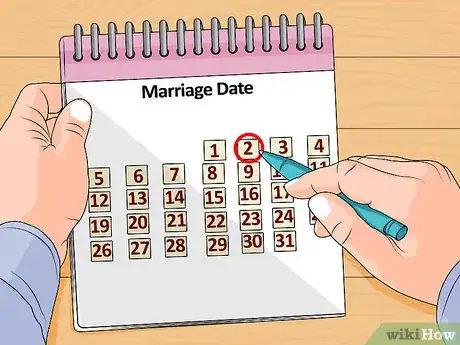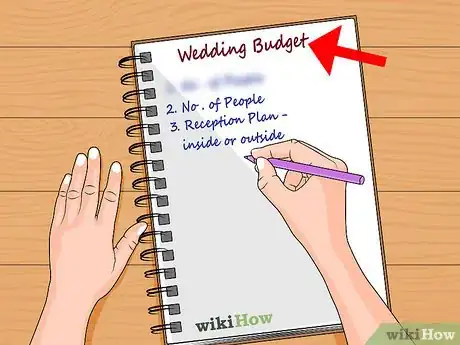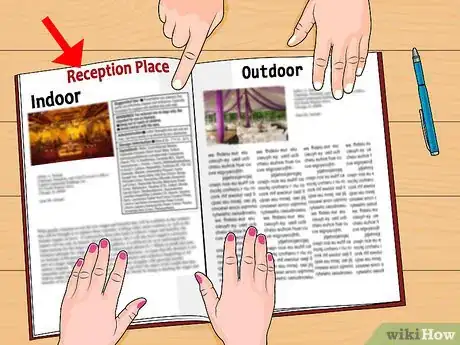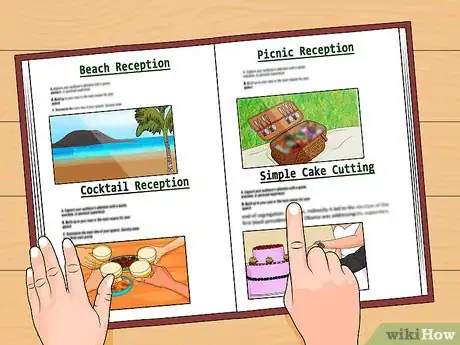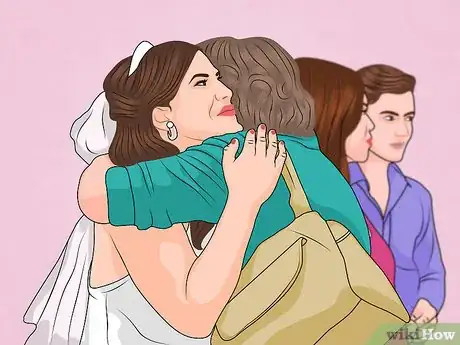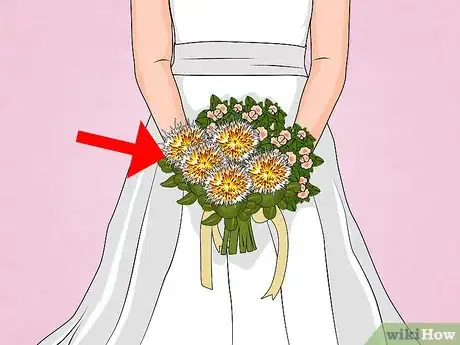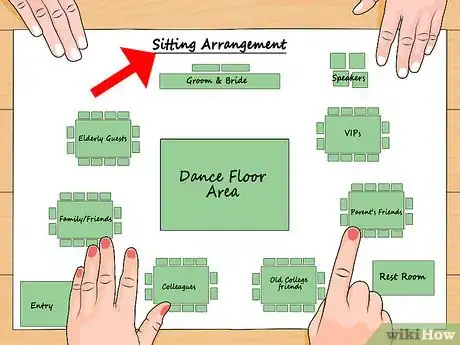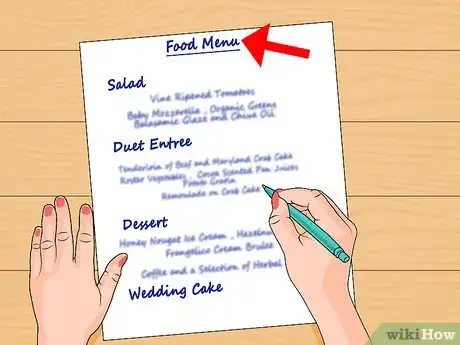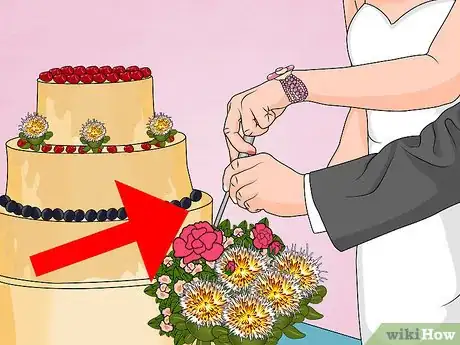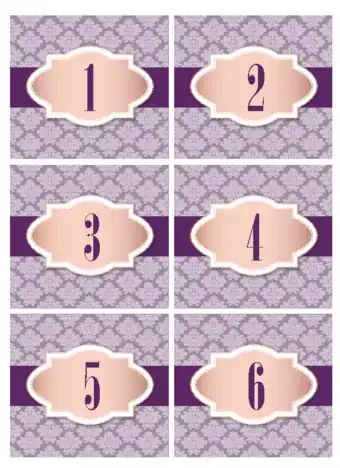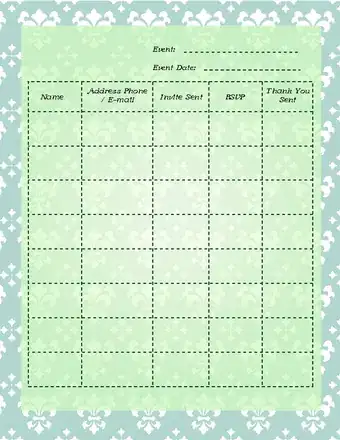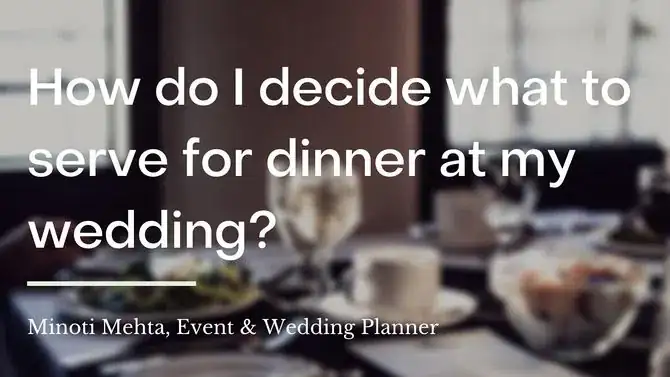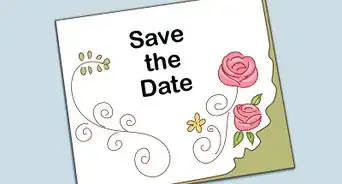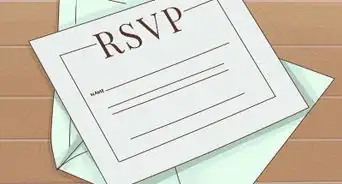This article was co-authored by Carole Grogan. Carole Grogan is the Owner and Head Event Designer for Bright Blue Events, an event planning company that specializes in weddings. Her team has planned beautiful, detailed weddings, as well as social and corporate events for over 10 years, taking care of details such as floral design, décor, staffing, and catering.
wikiHow marks an article as reader-approved once it receives enough positive feedback. In this case, 100% of readers who voted found the article helpful, earning it our reader-approved status.
This article has been viewed 362,237 times.
Planning your wedding reception can take a lot of effort and it all begins with deciding on the location of the reception and the type of reception. Fear not, it's a fairly methodical process provided you're aware of which things need to be covered and what's more, you can have a lot of fun with it too!
Steps
Deciding on key elements of a reception
-
1Decide whether your event will be indoors, outdoors, or both. If you want an outdoor event, you'll have to consider the possibility of rain and have an indoor alternative.[3]
- The season is crucial, particularly if you're on a tight budget. Planning your wedding reception in winter, at the end of January for instance, will save money or earn you a discount.
- In some cases, planning your wedding reception requires you choose between Saturday and Sunday as the most convenient days of the week. Usually, Sunday is less expensive.
-
2Decide on the type of reception you'd like to have. Nowadays the two main types of reception are a buffet or a sit-down meal, but other variants such as picnics, a simple cake-cutting, or a beach reception might also appeal. Here are some things to consider in relation to different reception types:
- Buffet: Lots of food will be served, and people sometimes have a tendency to take too much food or there might be a lot of food left over.
- Sit-down: It's traditional, guests tend to really appreciate it and it works well for speeches. On the downside, it can feel stuffy and over-planned. It can also be the most expensive option.
- Cocktail reception: It's hip and modern, and it's also enjoyed a lot by guests. It may cost a lot less than a sit-down, but it can suffer from feeling a bit disorganized and hard to gain the attention of guests for cake cutting and toasts.
- Picnic: Great for nature-loving couples, and easy to arrange catering can be done using your local favorite sandwich place. Since it's outdoors, there can be a risk of rain and some people might find this too informal for a wedding.
- Simple cake cutting: For those leaving the registry office, a simple affair of cutting a cake in the foyer, or in a local cafe or even at home might be enough to finish up the occasion with friends who have attended it. This tends to be suitable for very small parties and for people who really didn't want to have any reception fuss at all. Have tea, coffee, and few cookies or cupcakes as well.
- Beach or yacht reception: Like a picnic, this is outdoors and risks a change of weather but it can be a lot of fun and make for beautiful photos. Again, it may be too informal for some and sand or water may definitely get everywhere!
-
3Consider whether or not you'll have a receiving line. On the positive side, this can provide an opportunity to greet all guests and allows everyone to feel they've had the chance to congratulate you. On the downside, it can take a lot of time and it can begin to feel tiring for those on it. Some guests may also detest the formality of this and having to wait in line. Having divorced parents can also make this an awkward decision for some.
- If you do have one, this is the order: Bride's mother or parents, groom's mother or parents, bride, groom, maid of honor, then bridesmaids.
-
4Consider whether you'd like to be announced as you enter the reception. This can be a lot of fun and can be done simply and easily by the DJ or bandleader, saying something like "Ladies and Gentlemen, please welcome the newlyweds Bob and Billie (or Mr and Mrs)", and you can then take your places for dinner.
-
5Decide when to have the toasts and plan to keep them short. While these are both traditional and wonderful, they're a pain when they're too long, too maudlin, rude, or just plain dull. Make the toasts during or between dinner courses, with two or three people speaking each time.
- Ask all toasters to keep it short and have someone in the wedding party time keep - and be strict about it too.
- The bride and groom can speak just before cutting the cake.
-
6Decide when dancing will occur. Nowadays, most weddings tend to leave the dancing until all courses are finished rather than having dances between courses. Besides your wedding song, be sure to have songs people will really want to dance to, especially since three or four generations may be attending the reception.
- Does the bride wish to dance with her father and does the groom wish to dance with his mother? You could have a father and daughter as well as a mother and son dance sessions.
-
7Organize the photography of the reception. You will want reception photos as much as the ceremony photos. Organize pictures with family and friends, in special groups or at certain tables.[4]
- Do you want guests to take photos too? They could each be asked to email digital photos of the evening that they've taken; give them a central wedding photo email set up just for this purpose.
-
8Consider whether you wish to have any other ceremonial aspects. For example, you might wish to have the garter removal tradition in front of the guests. And you might wish to throw the bouquet at your reception, as per tradition.
Planning the food
-
1Choose the food. There will always be some people with dietary restrictions, so be prepared to provide vegetarian, gluten-free, and other variants as needed. It's a good idea to have asked guests in advance for advice concerning allergies. A cocktail reception will usually on have nibbles and finger foods but still have both vegetarian and non-vegetarian options available. Decide how many courses you want for a sit-down dinner and be sure to check this against your budget.[6]
- Sit-down dinners usually have menus printed up for them.
- Buffet style (help yourself) or serving at a table? There are also variants such as placing larger servings on the table for guests to help themselves from (family - or Russian service if the waiter holds the food), or plated (arrives at table already done), or French (waiters serve at the table), etc.
-
2Choose where the wedding cake will be placed during the reception. Decide when it will be cut.
- Do you want guests to share the cake as part of dessert or to take a piece home instead? Perhaps both?
- Ensure that the photographer is organized to take a photo of you cutting the cake.
Expert Q&A
-
QuestionHow do I decide what to serve for dinner at my wedding?
 Minoti MehtaMinoti Mehta is the Founder of Vermilion Weddings & Events, an event and wedding planning business based in San Francisco, California. Minoti grew up in the event and wedding planning space and has over five years of event planning experience. She has been invited to participate as a Delegate at five exclusive Event Planner Conferences including Destination Wedding Planners Congress and Planners Xtraordinaire and has become known as one of the Top Wedding and Event Planners in the San Francisco Bay Area. Minoti's work has been featured on NDTV India, Love Stories TV, Maharani Weddings, and WedWise India. Vermilion Weddings & Events was also awarded WeddingWire's Couple's Choice Award in 2018. Minoti has a BS in Hospitality Management and Accounting from the University of San Francisco.
Minoti MehtaMinoti Mehta is the Founder of Vermilion Weddings & Events, an event and wedding planning business based in San Francisco, California. Minoti grew up in the event and wedding planning space and has over five years of event planning experience. She has been invited to participate as a Delegate at five exclusive Event Planner Conferences including Destination Wedding Planners Congress and Planners Xtraordinaire and has become known as one of the Top Wedding and Event Planners in the San Francisco Bay Area. Minoti's work has been featured on NDTV India, Love Stories TV, Maharani Weddings, and WedWise India. Vermilion Weddings & Events was also awarded WeddingWire's Couple's Choice Award in 2018. Minoti has a BS in Hospitality Management and Accounting from the University of San Francisco.
Event & Wedding Planner
-
QuestionHow do you do assigned seating at a wedding?
 Carole GroganCarole Grogan is the Owner and Head Event Designer for Bright Blue Events, an event planning company that specializes in weddings. Her team has planned beautiful, detailed weddings, as well as social and corporate events for over 10 years, taking care of details such as floral design, décor, staffing, and catering.
Carole GroganCarole Grogan is the Owner and Head Event Designer for Bright Blue Events, an event planning company that specializes in weddings. Her team has planned beautiful, detailed weddings, as well as social and corporate events for over 10 years, taking care of details such as floral design, décor, staffing, and catering.
Professional Event Planner Consider who will enjoy sitting with whom and where in the room they'll sit. Seating people with similar qualities or experiences together is always a good idea. You can group friends from college, people you know from work, or single people you might want to meet. Also keep in mind where groups are located. You don't, for example, want to put a group of older guests near speakers, but would want younger people near the dancefloor.
Consider who will enjoy sitting with whom and where in the room they'll sit. Seating people with similar qualities or experiences together is always a good idea. You can group friends from college, people you know from work, or single people you might want to meet. Also keep in mind where groups are located. You don't, for example, want to put a group of older guests near speakers, but would want younger people near the dancefloor. -
QuestionWhat steps do I need to take to plan a small wedding reception?
 Community AnswerHere are the basics: 1. Location - Where will you hold the reception? 2. Set up - How will you decorate the place? 3. Guests - How many people will attend? 4. Food - Who will make the wedding and groom cakes? Will it be a buffet or a sit-down dinner? 5. Music - Will there be a live band, a DJ, or a stereo system?
Community AnswerHere are the basics: 1. Location - Where will you hold the reception? 2. Set up - How will you decorate the place? 3. Guests - How many people will attend? 4. Food - Who will make the wedding and groom cakes? Will it be a buffet or a sit-down dinner? 5. Music - Will there be a live band, a DJ, or a stereo system?
Warnings
- Be careful with alcohol; having drunkards appear in the midst of a wedding reception is fairly undesirable. Ask the venue/bar to provide plenty of non-alcoholic alternatives. Also, don't replenish the wine, etc., after dinner. Instead, bring out tea and coffee, and if guests want more alcohol, have them find their own at a bar in the venue.⧼thumbs_response⧽
Things You'll Need
- Venue
- Caterer
- Event Planner
- Choice of meal options
- Decorations
- Music
- Wedding cake
References
- ↑ https://www.modwedding.com/2016/12/plan-wedding-reception/
- ↑ https://www.modwedding.com/2016/12/plan-wedding-reception/
- ↑ https://www.theknot.com/content/how-to-plan-a-wedding
- ↑ https://lifehacker.com/10-things-i-wish-i-had-known-when-i-was-planning-my-wed-1566806538
- ↑ https://www.theknot.com/content/how-to-seat-guests-at-wedding-reception
- ↑ https://www.weddingwire.com/wedding-ideas/wedding-menu-rules
About This Article
When you’re planning your wedding reception, there are a few main things you’ll need to cover. Decide on a seating plan where your guests will be most likely to get along with each other. For food, choose between a buffet and traditionally served dishes and accommodate for everyone’s dietary restrictions. Plan your toasts for during or between dinner courses and ask the speakers to keep their toasts relatively short. Cut your cake after the last toast, then move onto your first dance. After your first dance, play popular, upbeat songs your guests can dance to. For more tips from our Event Planning co-author, including how to choose between different styles of reception, read on!
